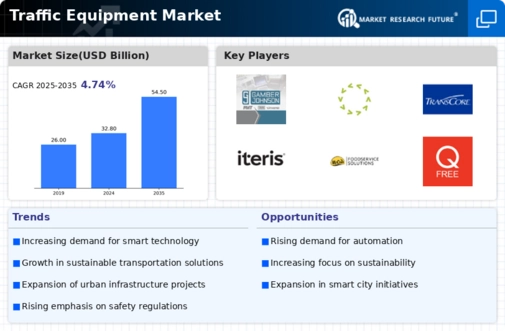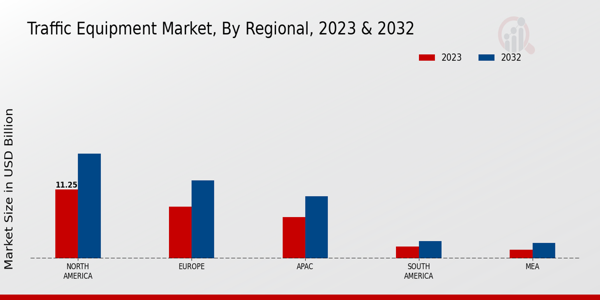Increasing Urbanization
The rapid pace of urbanization globally is a primary driver of the Global Traffic Equipment Market Industry. As more people migrate to urban areas, the demand for efficient traffic management solutions rises. Urban centers are projected to house over 68 percent of the world's population by 2050, necessitating advanced traffic equipment to manage congestion and enhance safety. This trend is likely to contribute to the market's growth, with the industry expected to reach 32.8 USD Billion in 2024. The need for smart traffic signals, automated enforcement systems, and real-time traffic monitoring solutions is becoming increasingly critical in urban environments.
Rising Vehicle Ownership
The increasing rate of vehicle ownership worldwide is a significant factor influencing the Global Traffic Equipment Market Industry. As more individuals acquire vehicles, the demand for effective traffic management solutions intensifies. In many developing regions, vehicle ownership is expected to rise sharply, leading to heightened congestion and necessitating advanced traffic control systems. This surge in vehicle numbers is likely to drive the market's growth, as cities seek to implement solutions that can accommodate the rising traffic volumes. The industry's expansion is further supported by the anticipated growth to 54.5 USD Billion by 2035, reflecting the need for innovative traffic management technologies.
Market Growth Projections
The Global Traffic Equipment Market Industry is poised for substantial growth, with projections indicating a market size of 32.8 USD Billion in 2024 and an anticipated increase to 54.5 USD Billion by 2035. This growth trajectory suggests a CAGR of 4.74% from 2025 to 2035, reflecting the industry's response to evolving traffic management needs. Factors such as urbanization, technological advancements, and government initiatives are expected to drive this expansion. The market's evolution will likely encompass a range of innovative solutions aimed at enhancing traffic efficiency and safety, positioning the industry for a robust future.
Technological Advancements
Technological innovations are transforming the Global Traffic Equipment Market Industry, leading to enhanced efficiency and safety in traffic management. The integration of artificial intelligence, machine learning, and IoT in traffic systems enables real-time data analysis and improved decision-making. For instance, adaptive traffic signal control systems can optimize traffic flow based on real-time conditions, reducing congestion and emissions. As cities invest in smart infrastructure, the market is anticipated to grow significantly, with projections indicating a rise to 54.5 USD Billion by 2035. These advancements not only improve traffic management but also contribute to sustainable urban development.
Government Initiatives and Regulations
Government policies and regulations play a crucial role in shaping the Global Traffic Equipment Market Industry. Many countries are implementing stringent traffic safety regulations and investing in infrastructure development to enhance road safety. For example, initiatives aimed at reducing traffic fatalities and improving public transport systems are driving demand for advanced traffic equipment. The global push for safer roads is likely to propel the market, as governments allocate funds for upgrading traffic management systems. This trend aligns with the projected CAGR of 4.74% from 2025 to 2035, indicating a sustained commitment to improving traffic safety and efficiency.
Environmental Concerns and Sustainability
Growing environmental concerns are increasingly influencing the Global Traffic Equipment Market Industry, as cities strive to reduce their carbon footprints. The push for sustainable transportation solutions is driving the adoption of eco-friendly traffic equipment, such as energy-efficient traffic signals and electric vehicle charging stations. Governments and organizations are prioritizing investments in green infrastructure to promote sustainable urban mobility. This trend is expected to contribute to the market's growth, with projections indicating a rise to 32.8 USD Billion in 2024. The integration of sustainability into traffic management strategies is likely to become a focal point for future developments in the industry.













